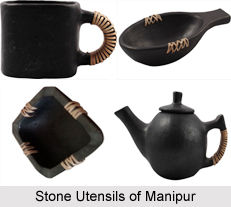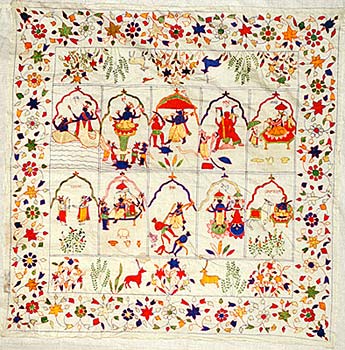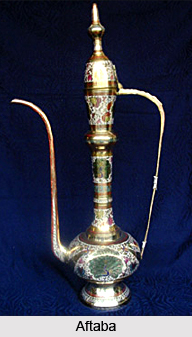The history of Bandhani or tie and dye can be dated back to pre-historic times, as countless dyers through the ages have experimented with the use of bindings to create patterns on cloth immersed in vats of dye. Different types of tie and dyes have been practiced in India, Japan, and Africa for centuries. Tie-dye became fully developed in China during the T`ang dynasty (618-906 A.D.) and in Japan during the Nara period (552-794 A.D.). The availability of silk and hemp, which are very useful to the resist technique, made these countries` art outstanding. Some early tribes in Western China, South East Asia, and Central America tied and dyed the threads before weaving their cloth. When it was woven into material, beautiful designs appeared where the white lines of the tie contrasted with the colour dyes. This method is known as Ikat.
The term `Bandhani` is derived from the word `Bandhan` that means tying up. It is an ancient art practise that is mainly used in the state of Rajasthan and Gujarat. Places like Jaipur, Udaipur, Bikaner, Ajmer and Jamnagar are the well known centres producing odhnis, sarees and turbans in Bandhani. It has an intimate link with social and religious customs of the different sections of the society and has evolved over the centuries. Some 5000 years ago Indian Bandhani, a traditional form of tie-dyeing was started. The craft was not practised on cotton as it was first used in India almost 3000 years back. Other forms of tie-dye can be found in other countries around the world. The Indian tie-dye technique called Bandhani is also known as Bandhej. Various other styles of tie-dye have emerged in the different nations of Africa and Japan. The Malay-Indonesian name for this technique is Plangi.
 In the early days dyes were extracted from roots, flowers, leaves, and berries. The extracts include blackberries, lichen, safflower, marigold, onion, red cabbage, sage, and indigo. In recent times synthetic dyes are being developed that are permanent, quick-setting, safe, easy to use, and are ensured by accurate formulas. Natural fibres are still the best option for tie-dyeing. Silks from China, Cottons from Egypt, and Rayon from Bali are highly prized material for this purpose. Silks Hemp has always been used as a durable and dye able natural fabric.
In the early days dyes were extracted from roots, flowers, leaves, and berries. The extracts include blackberries, lichen, safflower, marigold, onion, red cabbage, sage, and indigo. In recent times synthetic dyes are being developed that are permanent, quick-setting, safe, easy to use, and are ensured by accurate formulas. Natural fibres are still the best option for tie-dyeing. Silks from China, Cottons from Egypt, and Rayon from Bali are highly prized material for this purpose. Silks Hemp has always been used as a durable and dye able natural fabric.
Bandhani work in India has a rich history and the work was mainly started by the Muslim Khatri Community of Kutch. The women folk generally carry out the tradition from one generation to the other. The art of using bandhani includes using of a meter length of cloth with millions of tiny knots. The final products are known with various names like Khombi, Ghar Chola, Patori and also Chandrokhani etc.
In Japan from 1568 to 1603, Tsujigahana reached its height. This is an art combining tie-dye with ornamental drawing using Chinese ink called Sumi. Tie-dye is the entire design, or it can be used to create large areas where flowers, landscapes, and trees are drawn into the designs. Traditional dye shops developed new methods, such as Shibori for making elegant silk robes. In 1960`s Tie-dye is revived to its original form. Tie-dyed sheets were used as room dividers and wall hangings. Silk and cotton banners were used as backdrops for rock and roll concerts.
During 1980`s the re-emergence of tie-dyeing style required highly skilled, difficult and labour intensive art form. As a result many different colours can be put on a single item to get intricate detailed designs in brilliant colours. The easily removable dyes are now replaced by dyes that are permanent and easier to use. Pastels can be used for conservative designs. The modern technique of simultaneously applying different colours of dye directly to cotton became possible with the development of cold water fibre reactive dyes.



















